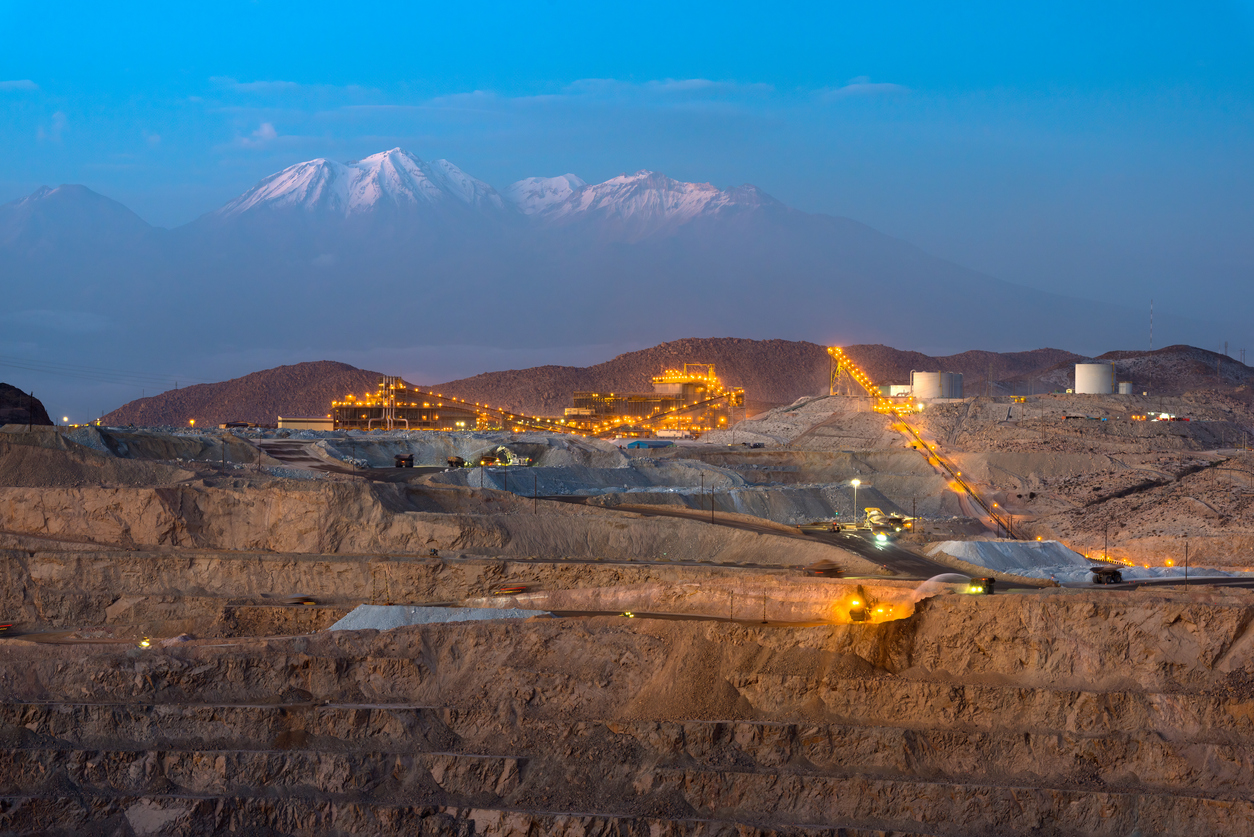
Copper prices have pulled back since a recent spike above $11,000 per tonne in March, but Goldman Sachs says that the ride higher isn’t over in 2022. Dramatic inventory shortages are to blame. In a note to clients, Goldman analysts said that they see a convincing case for prices to return to record highs by the end of the year. The bank has now revised its number higher to $13,000 per tonne.
Back in February 2022, Goldman indicated that a serious “scarcity episode” was occurring when stocks declined to about 200,000 tonnes. That amount was just enough to cover three days of global consumption, an extremely tight supply that could create chaos if not replenished fast enough.
The analysts boosted the anticipated deficit of refined metal for this year from previous forecasts by a factor of two, to 374,000 tonnes, and increased the shortfalls predicted over the following two years.
The investment bank’s three, six, and 12-month price targets are now all higher. Importantly, the bank sees a new price record in the next three months. That $13,000 price target? Analysts expect copper to climb to that level in just one year.
Another key indicator of the troubles ahead was what happened in March when stocks again declined on exchanges around the world. This is the first time in a decade this has happened considering this is usually the time that copper has a “…seasonal surplus phase.”
Goldman Sachs has historically been the biggest bull for copper, and it’s not the only one. JPMorgan increased its price target for the red metal, also due to a supply crunch.
The world is on an unprecedented path of growth and industrialization, and that is good news for copper bulls as demand continues to surge. Electric vehicles, batteries, 5G technology, and other factors are all working in favor of those who see higher prices ahead.
Beyond those macro factors, the supply crunch felt around the world is not expected to get any better. Factors such as coronavirus-related production delays, China’s crackdown on environmental violations, and a lack of new mines coming online are all working against those who need copper.
Inventories on the LME, the world’s largest copper market, have declined sharply since February, and are now at the lowest level in a decade. Inventories in China, the world’s largest copper consumer, have also been drawn down to extremely low levels.
While a surge in prices could be bad news for companies and consumers who need the metal for various reasons, it would be good news for producers. Companies such as Freeport-McMoRan (NYSE:FCX), Southern Copper (NYSE:SCCO), and Antofagasta (OTC:ANFGY) would all benefit if prices were to continue moving higher.
New copper projects are also scarce, and the explorers bringing new projects to fruition are finding valuations are soaring in the current climate.
The above references an opinion and is for information purposes only. It is not intended to be investment advice. Seek a licensed professional for investment advice. The author is not an insider or shareholder of any of the companies mentioned above.

Freeport McMoran Inc. (NYSE:FCX) produced less copper than expected from its mines in the Americas in the last quarter, heightening concerns about a tight global market where prices have soared to record levels. Freeport produced 987 million pounds of the metal in the third quarter, the company said in a statement on Thursday, with production falling below Bloomberg analysts’ average estimate of 1 billion pounds. The slowdown was driven by lower-than-expected output at its mines in South America.
The stock has more than doubled in the last year, becoming one of the best performers among copper suppliers tracked by Bloomberg Intelligence. The production shortage at Freeport comes after the company posted a quarterly profit that beat analyst estimates as higher copper prices helped lift sales and operating profit to levels last seen in the same quarter a year ago. Adjusted earnings of 89 cents per share topped the average estimate of 82 cents. Freeport estimates that annual copper sales are 3.8 billion pounds this year, following sales of 1.03 billion pounds in July and September. Net cash costs for Freeport were $1.24 per pound in the third quarter, well above the average analyst estimate of $1.30 per pound. Rising costs are seen as one of the few headwinds to earnings growth for the copper mining giant.
Freeport’s results will be particularly interesting for traders navigating the wild swings in copper prices, with available stocks on the London Metal Exchange at their lowest level since 1974. The market had been banking on Freeport to ramp up underground production. The company said underground progress at its flagship Grasberg mine was progressing on schedule. While companies are moving quickly to bring more copper to market, growth in demand is seen to be outstripping supply over the next decade, with new projects needed to help balance the dynamic.
Global shipping bottlenecks and energy bottlenecks in China and Europe have clouded the demand outlook for the coming year. But the immediate outlook for copper, supported by lower inventories and a shift to low-carbon energy sources, is rosier in the longer term. Efforts to save electricity in China and to limit emissions have been a double-edged sword for mining companies with higher smelting fees wiping out some of the windfall.
The China Conundrum
Coal provides much of the country’s electricity, but a combination of factors has recently led to electricity shortages. China’s coal production in 2021 will be unable to keep pace with rising electricity demand due to tighter safety regulations and an additional focus on environmental issues in Beijing, tight global coal markets, rising prices, and other factors, including weather delays. China is working out of a coal-fired power crisis that has sent shockwaves through its economy, but efforts to move to a low-carbon future are bringing additional risks to the country’s supply-demand balance. The shift has been too great, too fast, and the country is having trouble balancing its power needs with generating sufficient electricity using cleaner fuels.
Copper is one of the desperately needed metals for that clean energy transition. It is used for energy storage which is critical to use with renewables that are not able to generate electricity consistently. China is and will be one of the biggest copper consumers in the coming years, and will contribute to how fast demand will be driven.
Solar power can only be generated for a certain period, and when the night sets in, countries will need to draw power from the excess generated and stored in batteries. The lithium-ion batteries used to store large amounts of power require copper to be manufactured, and copper is the primary material for electricity transportation as well. To get the electricity from the generation site to the storage site, copper wiring will be used. More will be necessary to deliver that electricity to homes and offices and the factories that need to keep running almost constantly.
As China tries to shift to renewable energy, a severe drought has hit hydropower, especially in central Yunnan province. According to the National Development and Reform Commission, the water production in July and August fell by more than 4% year-on-year. Freeport’s production miss is significant because the producer accounts for so much of the global production, but the copper market remains strong. If anything, the lower production may only contribute to the supply crunch and rising copper prices.
The above references an opinion and is for information purposes only. It is not intended to be investment advice. Seek a licensed professional for investment advice. The author is not an insider or shareholder of any of the companies mentioned above.

Diavik property, Canada. Source: Rio TintoCopper stocks are on a tear this year, in no small part due to the rising price of copper as supply shortages and a surging demand boom converge to create some of the best conditions in recent history for stocks. While the current climate has been more than favourable for copper stocks, they have often had an advantage historically over gold and other precious metal stocks due to the red metal’s multiple industrial uses.
Rio Tinto (NYSE:RIO)
Producing iron ore, copper, diamonds, gold, and uranium, Rio Tinto is one of the largest mining companies in the world. The stock has doubled in the past year, reflecting the company’s return to near-full production capacity as well as a lifting of lockdown restrictions in the 35 countries it operates in globally.
Southern Copper Corporation (NYSE:SCCO)
With mining operations located in Peru and Mexico along with exploration operations in both those countries plus Chile, Southern Copper is one the largest integrated copper producers. The last year has seen SCCO stock soar 110%. Investors who have held the stock must be happy to see their positions double over the past 12 months.
Solaris Resources (TSX:SLS)
As a junior mining company, Solaris Resources holds a large amount of potential. The company is focused on its flagship Warintza project in Ecuador, for which it has reported positive assay results as it continues to expand the project to adjacent sites. Investors seem to like the progress, because the stock is up over 1000% since the IPO less than a year ago.
Freeport-McMoran Inc. (NYSE:FCX)
This company operates large and long-term geographically diverse assets that hold reserves of copper, gold, and molybdenum. The company’s scale is used to maintain a dominant position in the market, using properties like the Grasberg mineral district Indonesia, which is one of the largest copper and gold deposits in the world, to fortify its balance sheet. FCX stock is up 370% in the past year, as investors continue to pile into this veteran mining company delivering year after year.
Conditions Are Ripe for Copper Miners
Mining companies exploring and producing base metals like copper usually have higher dividend yields than hedges against inflation like gold stocks. They are also generally better value as they sit cheaper in relation to earnings and cash flow. With a low P/E, copper stocks usually have less distance to fall if markets take a hit, and the upside is higher when the stock runs. With lower risk and higher potential reward, copper stocks are always in favour with the investing community for short, and long-term plays.
Short-term, copper should be able to benefit from the rising demand coming from increased battery production and clean energy storage solutions. The increase of electric car sales and the electrification of infrastructure and power grids around the world requires huge amounts of copper to transport and store the energy. Labour shortages and technical delays in some regions of the world have also contributed to a general slowdown in copper production, but as 2021 rolls on, the environment is looking strong for copper mining companies and their stocks.
The above references an opinion and is for information purposes only. It is not intended to be investment advice. Seek a licensed professional for investment advice. The author is not an insider or shareholder of any of the companies mentioned above.

For countries to reap the rewards of their natural resources, they need to make sure there is a favourable climate for miners and businesses operating within their borders. For Ecuador’s new president Guillermo Lasso, that means welcoming mining companies with open arms as they work to build a sector that is critical to Ecuador’s national economy. Chile hosts some of the biggest mining companies in the world, including BHP Group Ltd. (NYSE:BHP), Anglo American Plc (LSE:AAL.L), Glencore Plc (GLNCY), Antofagasta Miners (LSE:ANTO.L), and Freeport-McMoRan Inc. (NYSE:FCX).
Walking a Tightrope
Recent discussions by lawmakers in Chile could throw the country’s status as a mining hotspot into question. If investors or companies get spooked by the new tax, it could hamper efforts to invest in new projects or expand the ones currently operating in the region. Particularly for proposed royalty deals on copper and lithium sales, the ongoing discussions now could throw a wrench into the works of years of planning and investment.
Foreign investment in the country is an essential source of stimulus and job creation. The mining industry contributes massively to the national economy, and it has made Chile the biggest copper-producing nation in the world. With the new bill approved just last week imposing higher taxes on sales, and cash generated based on the current running price of copper, those contributions could begin to dry up.
A Painful Tax
Initially, lawmakers wanted to impose a 3% flat royalty for mining companies extracting copper and lithium. The valuable metals have seen steady price increases over the years, and with the coming electrification of the global economy, this trend shows no signs of abating.
A new version of the bill proposes a marginal rate of 15% on sales with copper prices between $2 and $2.50 per pound and up to 75% on any revenue generated from fees about 4%. This sliding scale has miners concerned about the future of their operations in the country, as copper’s price seems to have no slowdown in sight. If the bill were approved today, with current copper prices, the royalty rate would be 21.5%. Miners would be able to discount refining costs and some other tax write-offs for any copper sold as refined cathode, but the cut would be almost prohibitive for them.
“You can absolutely try and take more from the golden goose…”
This proposed tax would hit the biggest mining companies the hardest, with the bill affecting miners that produce more than 12,000 tonnes of copper and 50,000 tonnes of lithium per year. One of the companies that would be affected is speaking out against the proposed bill, as it would cut into the country’s status as a mining partner for some of the largest mining companies in the world. According to Ragnar Udd, President of BHP Minerals Americas, “You can absolutely try and take more from the golden goose but you just need to be very clear on what the implications are on that long term. The sort of reforms that are being put forward at the moment will be really quite damaging to the industry.”
“These are tax levels akin to expropriation…”
Even though the proposed tax has miners worried for the future of their operations, it is unlikely that the bill will be passed, especially in its current form. He believes the current system is fine, under which miners are charged a variable rate of up to 14% on operating profit. This rate only applies to large producers and does not affect the less competitive mines, giving them a shot at growth and keeping the country competitive for international investors.
For now, worry and outright opposition are the state of play, as one prominent mining group president has already touched on. Resistance is strong, and this is unlikely to let the bill pass as is. Sonami president Diego Hernandez issued a statement calling the project unconstitutional. He made it clear that the consequences of the proposed bill on the industry and the country would be severe and damaging. With this bill, Sonami (an organization representing copper miners in Chile) predicts that 12 of the 15 biggest miners operating in the country would end up operating at a loss.
Diego Hernandez himself has made it clear that the bill is unacceptable: “These are tax levels akin to expropriation and this is going to inhibit investment immediately.”
The above references an opinion and is for information purposes only. It is not intended to be investment advice. Seek a licensed professional for investment advice. The author is not an insider or shareholder of any of the companies mentioned above.
If you would like to receive our free newsletter via email, simply enter your email address below & click subscribe.
CONNECT WITH US
Tweets
Tweet with hash tag #miningfeeds or @miningfeeds and your tweets will be displayed across this site.
MOST ACTIVE MINING STOCKS
Daily Gainers
 Romios Gold Resources Inc. Romios Gold Resources Inc. |
RG.V | +50.00% |
        |
HBK.V | +50.00% |
        |
ADD.V | +50.00% |
        |
BCU.V | +40.00% |
   |
HLX.AX | +33.33% |
        |
PLY.V | +33.33% |
        |
PLY.V | +33.33% |
 Comstock Mining, Inc. Comstock Mining, Inc. |
LODE | +33.33% |
        |
CASA.V | +30.00% |
   |
RMI.AX | +20.00% |
Articles
FOUND POSTS
Arras Minerals (TSXV:ARK) Updates on Elemes Drill Program in Kazakhstan
December 19, 2024

 Follow us on Twitter
Follow us on Twitter Become our facebook fan
Become our facebook fan







